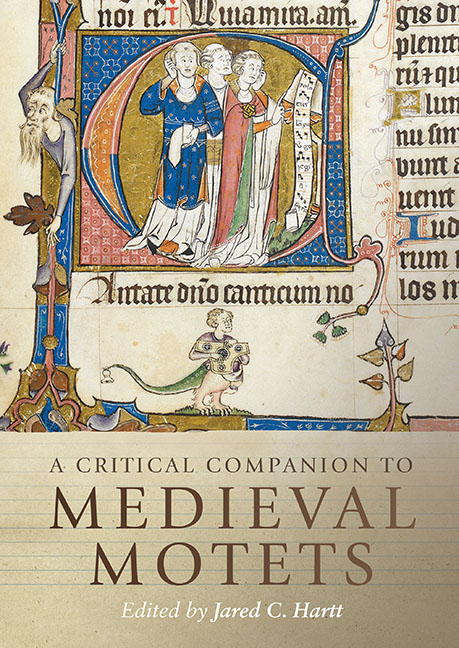Book contents
- Frontmatter
- Dedication
- Contents
- List of Figures
- List of Music Examples
- List of Tables
- List of Contributors
- Preface
- Acknowledgments
- Abbreviations
- Introduction: Approaching Medieval Motets
- 1 The Genre(s) of Medieval Motets
- 2 Origins and Interactions: Clausula, Motet, Conductus
- 3 Tracing the Tenor in Medieval Motets
- 4 Isorhythm
- 5 Notation
- 6 Thirteenth-Century Motet Functions: Views through the Lens of the Portare Motet Family
- 7 A Prism of its Time: Social Functions of the Motet in Fourteenth-Century France
- 8 Motets, Manuscript Culture, Mise-en-page
- 9 Clerics, Courtiers, and the Vernacular Two-Voice Motet: The Case of Fines amouretes / Fiat and the Roman de la poire
- 10 When Words Converge and Meanings Diverge: Counterexamples to Polytextuality in the Thirteenth-Century Mote
- 11 Motets in Chansonniers and the Other Culture of the French Thirteenth-Century Motet
- 12 Building a Motet around Quoted Material: Textual and Musical Structure in Motets Based on Monophonic Songs
- 13 The Duet Motet in England: Genre, Tonal Coherence, Reconstruction
- 14 Materia Matters: Reconstructing Colla/Bona
- 15 Machaut’s Motet 10 and its Interconnections
- 16 A Motet Conceived in Troubled Times: Machaut’s Motet 22
- 17 A Motet Ahead of its Time? The Curious Case of Portio nature/Ida capillorum
- Bibliography of Works Cited
- Select Glossary
- Index of Cited Motets
- General Index
- Studies in Medieval and Renaissance Music
6 - Thirteenth-Century Motet Functions: Views through the Lens of the Portare Motet Family
Published online by Cambridge University Press: 21 October 2020
- Frontmatter
- Dedication
- Contents
- List of Figures
- List of Music Examples
- List of Tables
- List of Contributors
- Preface
- Acknowledgments
- Abbreviations
- Introduction: Approaching Medieval Motets
- 1 The Genre(s) of Medieval Motets
- 2 Origins and Interactions: Clausula, Motet, Conductus
- 3 Tracing the Tenor in Medieval Motets
- 4 Isorhythm
- 5 Notation
- 6 Thirteenth-Century Motet Functions: Views through the Lens of the Portare Motet Family
- 7 A Prism of its Time: Social Functions of the Motet in Fourteenth-Century France
- 8 Motets, Manuscript Culture, Mise-en-page
- 9 Clerics, Courtiers, and the Vernacular Two-Voice Motet: The Case of Fines amouretes / Fiat and the Roman de la poire
- 10 When Words Converge and Meanings Diverge: Counterexamples to Polytextuality in the Thirteenth-Century Mote
- 11 Motets in Chansonniers and the Other Culture of the French Thirteenth-Century Motet
- 12 Building a Motet around Quoted Material: Textual and Musical Structure in Motets Based on Monophonic Songs
- 13 The Duet Motet in England: Genre, Tonal Coherence, Reconstruction
- 14 Materia Matters: Reconstructing Colla/Bona
- 15 Machaut’s Motet 10 and its Interconnections
- 16 A Motet Conceived in Troubled Times: Machaut’s Motet 22
- 17 A Motet Ahead of its Time? The Curious Case of Portio nature/Ida capillorum
- Bibliography of Works Cited
- Select Glossary
- Index of Cited Motets
- General Index
- Studies in Medieval and Renaissance Music
Summary
THIS CHAPTER, devoted to how the motet functions in the thirteenth century, draws its examples largely from a motet family based on the chant fragment portare; this melodic segment appears in the Alleluia: Dulce lignum (M22) for the celebrations of the Cross: its Invention on 3 May and its Exaltation on 14 September. A number of Parisian chant sources, including F-Pn lat. 1112, fol. 169v, shown in Example 6.1, use the word sustinere instead of portare, a fact that is not necessarily significant because the words are employed interchangeability in the Office liturgy for the feasts of the Cross. As indicated below the example, the text and melody also appear in a Marian version, Alleluia: Dulcis virgo, for the Octave of the Assumption, with the word portare. In this contrafactum, the image of the Cross bearing the weight of Christ changes to one of Mary carrying him, presumably both before birth and later as the infant Jesus. Thus, the chant segment possesses both Marian and Christological connotations, an essential fact as we turn to the exegetical function of motets.
As discussed in Catherine A. Bradley's chapter, many of the earliest thirteenth-century Latin motets result from the addition of a syllabic text to the upper voice of discant clausulae of the Magnus liber organi or its supplements. These new Latin texts allude to the plainsong from which the tenor chant melisma is taken or even to other liturgical items for the same feast. These motets thus function as exegetical vehicles in which the hermeneutic modes are applied to the Scriptural passages associated with the feast. Of the four hermeneutic modes – historia, allegoria, tropologia, and anagoge – the tropological figures strongly in the early Latin motet repertory. A new Latin upper-voice text often tropes the tenor chant, giving it a moral interpretation or significance apart from its direct meaning.
Alleluia: Dulce lignum, dulces claves, dulcia ferens pondera, que sola fuisti digna sustinere regem celorum et Dominum.
Alleluia: Sweet wood, sweet nails, bearing the sweet weight, you alone were worthy of bearing the Lord, king of heaven.
Alleluia: Dulcis virgo, dulcis mater, dulcia ferens pondera, que sola fuisti digna portare regem celorum et Dominum.
- Type
- Chapter
- Information
- A Critical Companion to Medieval Motets , pp. 131 - 154Publisher: Boydell & BrewerPrint publication year: 2018

